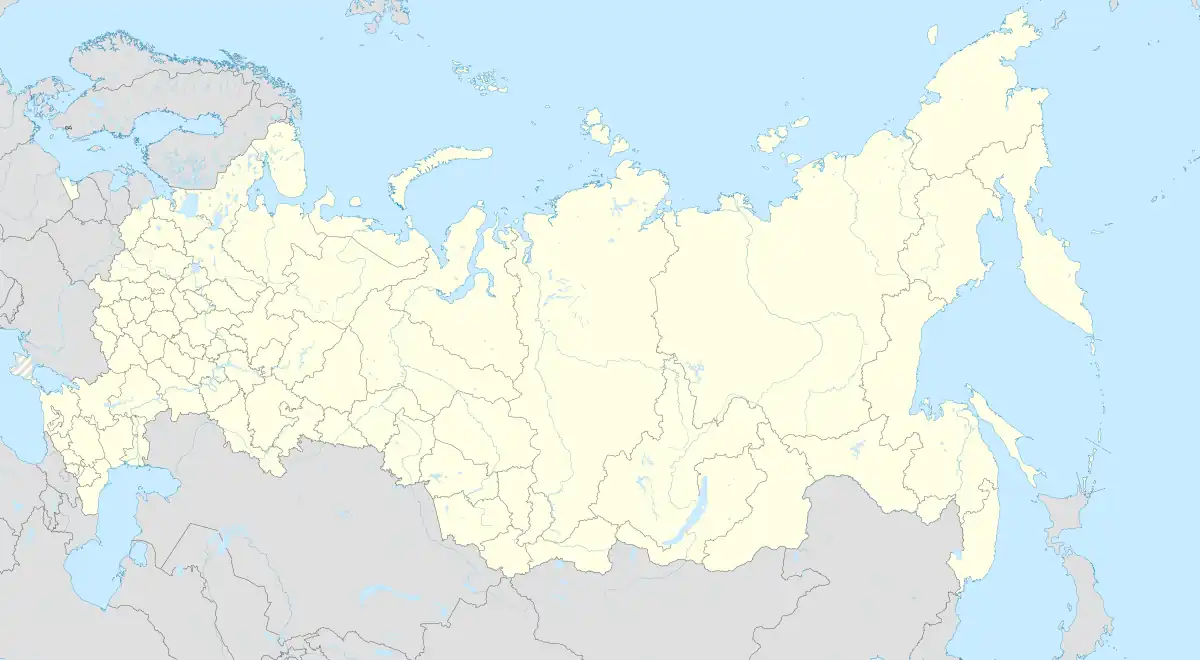Psedakh
Пседах | |
|---|---|
| Other transcription(s) | |
| • Ingush | Долакоа[lower-alpha 1] |
Location of Psedakh | |
 Psedakh Location of Psedakh  Psedakh Psedakh (Republic of Ingushetia) | |
| Coordinates: 43°28′06″N 44°34′14″E / 43.46833°N 44.57056°E | |
| Country | Russia |
| Federal subject | Ingushetia |
| Founded | 1820[5] |
| Elevation | 460 m (1,510 ft) |
| Population | |
| • Total | 4,606 |
| • Estimate (2021)[7] | 6,066 |
| • Subordinated to | Malgobeksky District |
| Time zone | UTC+3 (MSK |
| Postal code(s)[9] | 386332 |
| OKTMO ID | 26615410101 |
Psedakh (Ingush: Долакоа, romanized: Dolakoa[lower-alpha 1]) is a rural locality (a selo) in the Malgobeksky District of the Republic of Ingushetia, Russia. It forms the municipality of the rural settlement of Psedakh as the only settlement in its composition.[10][11]
Etymology
Psedakh is a distorted version of the toponym, going back to the Kabardian Psydakhe (Kabardian: псы дахэ) which means "beautiful water/river".[12]
History
The village was founded in 1820[5] on the territory of Little Kabardia. The land was purchased from the Little Kabardian princes Bekovich-Cherkassky and subsequently, in the 1860s, it was added to the Nazranian society.[13]
In 1926, the village was the center of the Achalukovsky District of the Ingush Autonomous Oblast and at the same time the center of the Psedakh village council which in addition to Psedakh, also included farms of Vostochny Sovetsky, Doholber, Zapadny Sovetsky, and Mazaevsky which arose in 1920–1921. In the village itself, there were 344 households (325 peasants and 19 non-peasant), and 1802 people lived (884 males and 918 females).[5]
Until 1944, the village was the administrative center of the Psedakhsky District of the Chechen-Ingush ASSR. In 1944, after the Deportation of the Chechens and Ingush and the abolition of the Chechen-Ingush Autonomous Soviet Socialist Republic, the village of Psedakh was renamed Alanskoe.[14] After the restoration of Chechen-Ingush autonomy in 1957, the settlement was returned to its former name – Psedakh.
Geography
The village is located in the western part of the Malgobeksky District and is located south of the district center of the city of Malgobek, 35 km in a straight line northwest of the city of Magas, the capital of Ingushetia. In the northeast, the village of Sagopshi adjoins Psedakh, in the west – the village of Inarki, the nearest settlement in the southeast is Geyrbek-Yurt, in the southwest — Batako (North Ossetia).
The settlement is located at the northern foot of the Sunzha Range, in the foothill zone. To the south of the village rises Mount Musakai (872.5 m), and to the southeast – Mount Babalo (818.1 m). Altitude fluctuations in the village are 420–540 meters above sea level.[15]
The hydrographic network is represented by the small river Psedakh, which originates on the northern slope of Mount Musakai and flows through the village. To the west of it, also on the northern slope of the Sunzha Range, the Zhoronka river originates.[16]
The climate is moderately cold humid (Dfb). The amplitude of air temperature ranges from an average of +21.7°С in July to an average of −3.5°С in January. The average annual rainfall is 677 mm. The main amount of precipitation falls between April and August.[17]
Notes
References
- ↑ Мальсагов 1963, p. 144.
- ↑ Оздоев 1980, p. 831.
- ↑ Барахоева, Кодзоев & Хайров 2016, p. 23.
- ↑ Кодзоев 2021, p. 446.
- 1 2 3 "Список населённых пунктов по Ингушской АО, составленный по материалам Всесоюзной переписи населения 1926 года". vivaldi.dspl.ru. p. 7.
- ↑ Russian Federal State Statistics Service (2011). Всероссийская перепись населения 2010 года. Том 1 [2010 All-Russian Population Census, vol. 1]. Всероссийская перепись населения 2010 года [2010 All-Russia Population Census] (in Russian). Federal State Statistics Service.
- ↑ "Таблица 5. Численность населения России, федеральных округов, субъектов Российской Федерации, городских округов, муниципальных районов, муниципальных округов, городских и сельских поселений, городских населенных пунктов, сельских населенных пунктов с населением 3000 человек и более". Всероссийской переписи населения 2020 года
- ↑ "Об исчислении времени". Официальный интернет-портал правовой информации (in Russian). June 3, 2011. Retrieved January 19, 2019.
- ↑ Почта России. Информационно-вычислительный центр ОАСУ РПО. (Russian Post). Поиск объектов почтовой связи (Postal Objects Search) (in Russian)
- ↑ "Закон Республики Ингушетия от 23 февраля 2009 года № 5-рз «Об установлении границ муниципальных образований Республики Ингушетия и наделении их статусом сельского поселения, муниципального района и городского округа»".
- ↑ "Поиск кодов ОКАТО. Сельское поселение Пседах, Малгобекский район". www.ocato.ru.
- ↑ Зязиков 2004, p. 82.
- ↑ Горная Летопись // Сборник сведений о кавказских горцах. Вып. II (in Russian). Тифлис: Типография Главного Управления Наместника Кавказского. 1869. p. 51.
- ↑ "В Президиум Верховного Совета РСФСР. Президиум Верховного Совета Северо-Осетинской АССР просит утвердить его постановление о переименовании населённых пунктов в новых районах, вошедших в состав Северо-Осетинской АССР…". www.ingusheti.ge.
- ↑ Лист карты K-38-18 Малгобек. Масштаб: 1 : 100 000. Состояние местности на 1983 год. Издание 1988 г.
- ↑ "Росреестр. Публичная кадастровая карта". pkk5.rosreestr.ru.
- ↑ "Климат Пседаха". ru.climate-data.org.
Bibliography
- Мальсагов, З. К. (1963). Оздоева, Ф. (ed.). Грамматика ингушского языка [Grammar of the Ingush language] (in Ingush and Russian). Vol. 5 (2nd ed.). Грозный: Чечено-Ингушское Книжное Издательство. pp. 1–164.
- Оздоев, И. А. (1980). Оздоева, Ф. Г.; Куркиев, А. С. (eds.). Русско-ингушский словарь: 40 000 слов [Russian-Ingush dictionary: 40,000 words] (in Ingush and Russian). Москва: Русский язык. pp. 1–832.
- Барахоева, Н. М.; Кодзоев, Н. Д.; Хайров, Б. А. (2016). Ингушско-русский словарь терминов [Ingush-Russian dictionary of terms] (in Ingush and Russian) (2nd ed.). Нальчик: ООО «Тетраграф». pp. 1–288.
- Кодзоев, Н. Д. (2021). Хайрова, Р. Р. (ed.). Русско-ингушский словарь [Russian-Ingush dictionary] (in Ingush and Russian). Ростов-на-Дону. pp. 1–656. ISBN 978-5-906785-55-8.
{{cite book}}: CS1 maint: location missing publisher (link) - Зязиков, М. М. (2004). Традиционная культура ингушей: история и современность [Traditional culture of the Ingush: history and modernity] (in Russian). Ростов-на-Дону: СКНЦ ВШ. pp. 1–312. ISBN 5-87872-302-6.